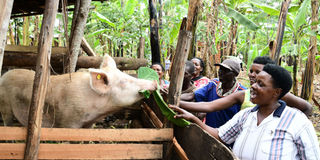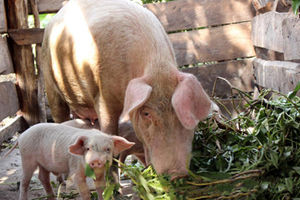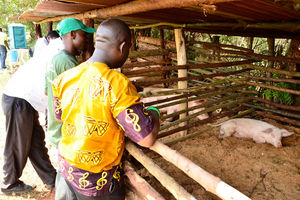
Members of Rwabiruka Bwanda Development Group, one of the many Savings and Credit Cooperatives in Rukungiri that are involved in piggery at their collective farm in Rwabiruka. PHOTO/NMG
“You have come to kill the area,” Canon Ezra Bataka bellowed as he wagged an accusing finger at Dr Sam Akankwasa.
Dr Akankwasa is the chairperson and founder of Rukungiri Producer Cooperative Union (RPCU).
The man of God launched the tirade to protest the activities of the cooperative which had embarked on the promotion and popularisation of piggery in greater Ankole, a traditionally cattle keeping area where rearing of pigs had always been associated with lesser mortals.
“People told me, that they only rare cows and maybe goats. Piggery is for failures. We are successful people. We are rich. How do you take us into pigs?” they told me,” he recounts.

Dr Sam Akankwasa, the chairman and founder of Rukungiri Producer Cooperative Union (RPCU) shows off some of the pigs in the demonstration farm.
Essence
It is however important to note that it was not as much because of the need to heed the government’s call on financial inclusion that Dr Akankwasa chose to champion piggery.
Population pressure had resulted into the loss of most of the top soils. That also meant the loss of most of the organic matter including plant-available phosphorous (P), and potassium (K). That negatively affected crop yields and animal production.
This led to migration to other areas where land could be found, but those who stayed had to make deliberate interventions aimed at finding inputs that could help offset the loss of inherent fertility.
Why pigs?
The introduction of piggery in a region that had never believed in pigs was identified as the best way to help the soils to regain their fertility.
“A few scientists arrived at the conclusion that manure from pigs lasts longer in the soils. Whereas other animals such as cows will give you organic manure, the soils will have lost their fertility within six months of you adding it, but 14 years down the road, that of the pigs will still be in the soil. The soils will still be fertile,” Dr Akankwasa says.
That would come as welcome news in a country whose loss of soil nutrients remains one of the highest in Africa yet fertiliser use remains extremely low.
Whereas Uganda committed itself at the 2006 Abuja Fertiliser Summit to increase fertiliser application levels to at least 50 kg of nutrients per hectare per year by 2015, the country has never met the target.
The National Fertiliser Policy indicates that Ugandan farmers only add between 1 and 1.5kg of fertilisers per hectare per year, which is far below the Sub Saharan average of 8 kg per hectare per year.
The paper, “Agricultural information and fertiliser use among farmers in Uganda,” indicates that only 5 percent of Ugandan farmers use fertilisers.

Jolly Twinamatsiko Kemiruka, chairperson of Rwerere Women Entrepreneurs Group, feeding some of the animals at the group’s farm. PHOTO/NMG
Pig urine
The pig urine too came across as one that would come handy as a manure and weapon against pests and fungal infections.
“When we mix pig urine with other compounds and spray on a crop, no pest or fungi will touch it. A farmer who has access to pig urine does not need to go and spend money on expensive pesticides,” he says.
The pig urine, according to Dr Akankwasa, is so concentrated that a 500 millilitre cap had been mixed with 20 litres of water and still remain devastatingly effective against fungi and pests.
The rollout
The rollout in terms of equipping the populace with knowledge on piggery commenced around 2007, but it was always met with resistance.
“The initial training took six months here without me leaving for a single day. Each day we were getting hundreds of people learning, but of course they were not accepting,” Dr Akankwasa says.
According to Ms Jolly Twinamatsiko Kemiruka, a resident of Rushoroza A village in Rwerere Town Council, Rukungiri District, the resistance was premised on the myth that presence of pigs in the same environs as cows would cause the latter to die.
“Our culture, we the Banyankole and Bahororo does not allow us to have pigs and cows at the same time. Dairy farming and piggery do not go together,” Ms Twinamatsiko says.
Ms Kemiruka who is the chairperson of Rwerere Women Entrepreneurs Group, and the 12 other members of the said group were some of the first people to debunk the myth and take up piggery. The group runs a collective piggery farm in Rwerere Town Council. Individual group members also practice piggery on their own small holdings.
Game changer
President Museveni’s entry on the scene early in 2010 was a game changer. He funded the provision of 500 pigs of different species.
That precipitated the commencement of practical training and subsequently distribution of pigs, two females and one male, to each group, but the exercise soon ran into a wall.
The cooperative ran out of pigs to distribute. They returned to President Museveni who pointed them to the Microfinance Support Centre (MSC).
MSC and Rukungiri Producer Cooperative Union signed a Memorandum of Understanding (MOU) aimed at promoting piggery in a sustainable manner.
MSC undertook to fund the opening in Rukungiri, of a pig breeding centre that would not only also serve as a source of pigs for distribution, but also serve as a demonstration farm where practical knowledge could be imparted.
“With the coming in of Microfinance Support Centre, we’ve been able to continuously train our people. They are seeing and learning for free. People needed to see because seeing is learning. And seeing is believing. If you are telling them that one pig equals to 10, can they see a pig with 10 piglets? If you are saying that there are breeds like the Duroc, Large White or Camborough, can they be able to see it there on the farm,” Dr Akankwasa says.
That refers to the teaching that a pig will in one year and two months produce three times. That means that if a mother pig produces 10 piglets every 4 months, one will have accumulated a total of 30 pigs in 12 months.
And if the first line of piglets 10 that mother pig gave birth to matures and also give birth, each to 10 piglets, the farmer will have accumulated another 100 piglets. That means that the farmer will have accumulated 130 pigs in 12 months. Since the commencement on September 22, 2021 of the terms of the MOU, MSC has been conducting trainings in financial literacy and providing funding for continuous training in piggery and outreaches aimed at assessing performance and identifying the challenges of the beneficiary groups.

Winston Muhairwe, a member of Rwakabengo A Multipurpose Group, in Rukungiri Town, one of the groups that have made the foray into piggery.
Impact
The results have been amazing. Mindsets have changed. The thinking that cows die if they are near pigs is fast fading.
Among those whose views on piggery have since done a 360 degree turn around is Canon Ezra Bataka, who has since taken to piggery. His Bataka Holdings Limited, is now one of the biggest pig farms in Rukungiri District.
His road to Damascus moment was the Covid-19 pandemic. The lockdown that government introduced as a containment measure triggered the fall in prices for matooke from between Shs10,000 and Shs15,000 during the pre-lockdown period to within the region of Shs1,000 and Shs2,000 per bunch.
“The market completely failed (during the lockdown). A friend of mine told me, now you are losing the bananas. If you get pigs, they can be feeding on the bananas,” the 92-year-old says.
A return to Dr Akankwasa’s farm for manure inadvertently resulted into the acquisition of two pigs that kick-started his foray into piggery. He does not regret it and is looking to grow even bigger.
“I have about 120 pigs now, but my plan, if all goes well is to have at least 500 pigs. Though we have challenges with mash to feed them, I have started planting elephant grass. We can use that and bananas to feed them,” he says.
Besides the big farmers like Canon Bataka. Another 4,000 individuals have since taken to piggery as an income generating activity, but the MSC has set the cooperative a target of 10,000 by the end of this year. Where are they?
“We are not yet there, but we are (moving) towards there,” Dr Akankwasa says, the hope unmistakeable.



